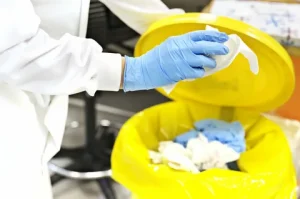Waste from the healthcare industry has a serious negative impact on the environment and public health and is quite expensive. While the European Union and the World Health Organisation (WHO) refer to it as “healthcare waste,” several nations, including the US, South Korea, and China, use the phrase “medical waste”.
Healthcare waste (medical waste) is defined by the World Health Organisation (WHO) as any waste or by-product from hospitals and healthcare facilities for people and animals that were used for diagnosis, treatment, or immunization, such as used syringes, needles, metal sharps, dressings, blood samples, body parts, pharmaceutical, chemical, and radioactive materials and devices. Additionally, the production and disposal of waste from the medical and healthcare industries contribute to higher pollution and GHG emission levels.
The global medical waste management market was valued at USD 15.3 Billion in 2020, while it’s projected to surpass a valuation of USD 25.2 Billion by end of 2028.
Moreover, the market is expected to show growth due to stringent regulatory frameworks that demand sustainable actions in many countries, which has helped to improve overall waste management practices. For example, in the United States, the Environmental Protection Agency (EPA) and the Occupational Safety and Health Administration (OSHA) have established regulations to ensure the safe handling, storage, and disposal of medical waste.
Besides, a number of non-governmental and community-based organizations are participating in assisting hospitals and other healthcare facilities to recycle, collect, and dispose of medical waste. The bulk of medical waste container consumption will likely increase demand further.

Face Masks Contribute to Nearly 30% of total Waste from Hospitals.
Face masks make up a large portion of medical waste (MW), especially after their use skyrocketed as a result of COVID-19 and laws requiring their use. Plastic trash accounted for around 30% of the total waste produced by hospitals, according to the findings of a recent study, that comprised seven hospitals and medical centers in the state of Massachusetts, the USA, along with three veterinary facilities.
Face masks are made from nonwoven polyurethane, polypropylene, or polyacrylonitrile textiles. But these materials don’t degrade easily; instead, they break down into smaller pieces and particles that become microplastics.
In addition, the usage of latex or plastic hand gloves for protection by common people and workers in many industries during the pandemic resulted in an increase in the number of gloves disposed of. Due to their toxicity, infectiousness, and occasionally radioactivity, 15 to 20% of medical wastes, according to estimations by the WHO, can be categorized as hazardous materials. However, due to the lack of clarity and decisiveness in this classification, medical waste management practices are not uniform or consistent across all nations.
The plastics polyvinylchloride (PVC), polyethylene (PE), polypropylene (PP), polyurethane (PU), and copolymers are mostly used to produce operating room tools and equipment. The first three kinds of plastic can be recycled and already are. Since most operating room waste is created before the arrival of the patient and is not contaminated or infectious, it may often be categorized as non-hazardous.
Lack of Standardization Hinders Medical Waste Management
Waste Segregation identifies the different waste categories and demonstrates how each can be gathered separately. Medical waste is segregated according to its type and potential hazard level. The segregation process typically involves using color-coded containers or bags to identify different types of waste.
The lack of standardization of the colors associated with each waste category, creates a problem when collecting from different sources, increasing the amount of time and money required for labor and equipment to separate the waste and direct it to the appropriate waste stream. However, automatic waste collection systems are increasingly being adopted by organizations to collect waste. With the exception of trash that is being treated at the same facility, most segregation should take place at the point source.
Even in the Post-Pandemic Era Medical Waste Management is Expected to Rise.
The medical waste management market is expected to witness good growth in the post-pandemic era owing to increasingly strict mandates being introduced by governments across the world to manage waste and focus on environmental conservation. Medical sterilization was a prime trend during the pandemic and increased awareness of hospital-acquired infections (HAIs) is expected to propel the demand for medical sterilization in the post-pandemic era as well.
Circular Economy Approach to Promote Reduce, Reuse, Recycle of Medical Waste.
There has been a consistent rise in research for exploring distinct possibilities for treating medical waste. Research has focused on the development of biodegradable packaging materials for medical waste, which can help to reduce the environmental impact of waste disposal.
Researchers have developed new disinfection technologies for medical waste, such as ozone and ultraviolet radiation, that can effectively sterilize waste without the need for incineration. The adoption of a circular economy approach to medical waste management can help to reduce waste generation and promote the reuse, recycling, and repurposing of materials.
Overall, the future possibilities in medical waste management offer exciting opportunities for innovation and sustainability in the healthcare industry. By leveraging advanced technologies and adopting new approaches to waste management, companies can help to ensure the safety of their employees and patients, protect the environment, and promote a more sustainable future.



